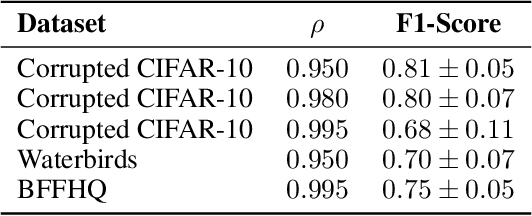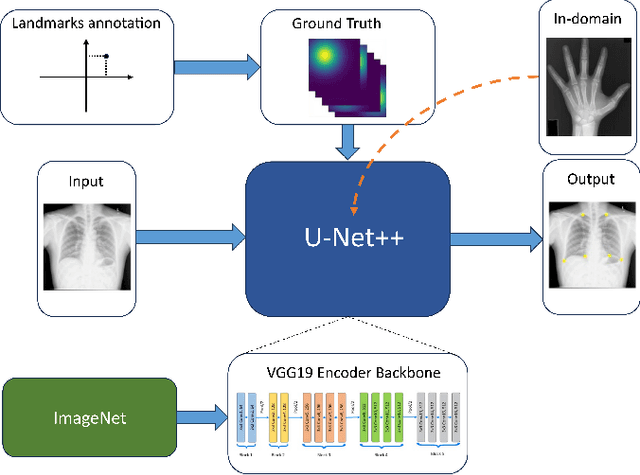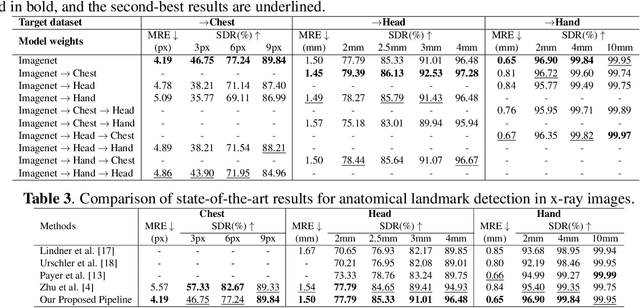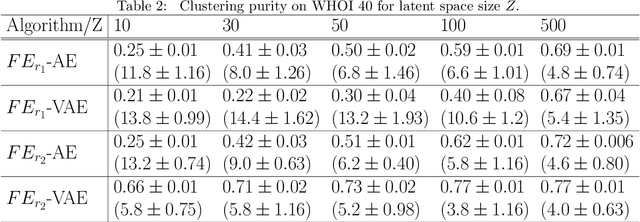Vito Paolo Pastore
DIMA: DIffusing Motion Artifacts for unsupervised correction in brain MRI images
Apr 09, 2025Abstract:Motion artifacts remain a significant challenge in Magnetic Resonance Imaging (MRI), compromising diagnostic quality and potentially leading to misdiagnosis or repeated scans. Existing deep learning approaches for motion artifact correction typically require paired motion-free and motion-affected images for training, which are rarely available in clinical settings. To overcome this requirement, we present DIMA (DIffusing Motion Artifacts), a novel framework that leverages diffusion models to enable unsupervised motion artifact correction in brain MRI. Our two-phase approach first trains a diffusion model on unpaired motion-affected images to learn the distribution of motion artifacts. This model then generates realistic motion artifacts on clean images, creating paired datasets suitable for supervised training of correction networks. Unlike existing methods, DIMA operates without requiring k-space manipulation or detailed knowledge of MRI sequence parameters, making it adaptable across different scanning protocols and hardware. Comprehensive evaluations across multiple datasets and anatomical planes demonstrate that our method achieves comparable performance to state-of-the-art supervised approaches while offering superior generalizability to real clinical data. DIMA represents a significant advancement in making motion artifact correction more accessible for routine clinical use, potentially reducing the need for repeat scans and improving diagnostic accuracy.
Diffusing DeBias: a Recipe for Turning a Bug into a Feature
Feb 13, 2025Abstract:Deep learning model effectiveness in classification tasks is often challenged by the quality and quantity of training data which, whenever containing strong spurious correlations between specific attributes and target labels, can result in unrecoverable biases in model predictions. Tackling these biases is crucial in improving model generalization and trust, especially in real-world scenarios. This paper presents Diffusing DeBias (DDB), a novel approach acting as a plug-in for common methods in model debiasing while exploiting the inherent bias-learning tendency of diffusion models. Our approach leverages conditional diffusion models to generate synthetic bias-aligned images, used to train a bias amplifier model, to be further employed as an auxiliary method in different unsupervised debiasing approaches. Our proposed method, which also tackles the common issue of training set memorization typical of this type of tech- niques, beats current state-of-the-art in multiple benchmark datasets by significant margins, demonstrating its potential as a versatile and effective tool for tackling dataset bias in deep learning applications.
Assessing the use of Diffusion models for motion artifact correction in brain MRI
Feb 03, 2025Abstract:Magnetic Resonance Imaging generally requires long exposure times, while being sensitive to patient motion, resulting in artifacts in the acquired images, which may hinder their diagnostic relevance. Despite research efforts to decrease the acquisition time, and designing efficient acquisition sequences, motion artifacts are still a persistent problem, pushing toward the need for the development of automatic motion artifact correction techniques. Recently, diffusion models have been proposed as a solution for the task at hand. While diffusion models can produce high-quality reconstructions, they are also susceptible to hallucination, which poses risks in diagnostic applications. In this study, we critically evaluate the use of diffusion models for correcting motion artifacts in 2D brain MRI scans. Using a popular benchmark dataset, we compare a diffusion model-based approach with state-of-the-art methods consisting of Unets trained in a supervised fashion on motion-affected images to reconstruct ground truth motion-free images. Our findings reveal mixed results: diffusion models can produce accurate predictions or generate harmful hallucinations in this context, depending on data heterogeneity and the acquisition planes considered as input.
Say My Name: a Model's Bias Discovery Framework
Aug 18, 2024Abstract:In the last few years, due to the broad applicability of deep learning to downstream tasks and end-to-end training capabilities, increasingly more concerns about potential biases to specific, non-representative patterns have been raised. Many works focusing on unsupervised debiasing usually leverage the tendency of deep models to learn ``easier'' samples, for example by clustering the latent space to obtain bias pseudo-labels. However, the interpretation of such pseudo-labels is not trivial, especially for a non-expert end user, as it does not provide semantic information about the bias features. To address this issue, we introduce ``Say My Name'' (SaMyNa), the first tool to identify biases within deep models semantically. Unlike existing methods, our approach focuses on biases learned by the model. Our text-based pipeline enhances explainability and supports debiasing efforts: applicable during either training or post-hoc validation, our method can disentangle task-related information and proposes itself as a tool to analyze biases. Evaluation on traditional benchmarks demonstrates its effectiveness in detecting biases and even disclaiming them, showcasing its broad applicability for model diagnosis.
Looking at Model Debiasing through the Lens of Anomaly Detection
Jul 25, 2024



Abstract:It is widely recognized that deep neural networks are sensitive to bias in the data. This means that during training these models are likely to learn spurious correlations between data and labels, resulting in limited generalization abilities and low performance. In this context, model debiasing approaches can be devised aiming at reducing the model's dependency on such unwanted correlations, either leveraging the knowledge of bias information or not. In this work, we focus on the latter and more realistic scenario, showing the importance of accurately predicting the bias-conflicting and bias-aligned samples to obtain compelling performance in bias mitigation. On this ground, we propose to conceive the problem of model bias from an out-of-distribution perspective, introducing a new bias identification method based on anomaly detection. We claim that when data is mostly biased, bias-conflicting samples can be regarded as outliers with respect to the bias-aligned distribution in the feature space of a biased model, thus allowing for precisely detecting them with an anomaly detection method. Coupling the proposed bias identification approach with bias-conflicting data upsampling and augmentation in a two-step strategy, we reach state-of-the-art performance on synthetic and real benchmark datasets. Ultimately, our proposed approach shows that the data bias issue does not necessarily require complex debiasing methods, given that an accurate bias identification procedure is defined.
Self-supervised pre-training with diffusion model for few-shot landmark detection in x-ray images
Jul 25, 2024



Abstract:In the last few years, deep neural networks have been extensively applied in the medical domain for different tasks, ranging from image classification and segmentation to landmark detection. However, the application of these technologies in the medical domain is often hindered by data scarcity, both in terms of available annotations and images. This study introduces a new self-supervised pre-training protocol based on diffusion models for landmark detection in x-ray images. Our results show that the proposed self-supervised framework can provide accurate landmark detection with a minimal number of available annotated training images (up to 50), outperforming ImageNet supervised pre-training and state-of-the-art self-supervised pre-trainings for three popular x-ray benchmark datasets. To our knowledge, this is the first exploration of diffusion models for self-supervised learning in landmark detection, which may offer a valuable pre-training approach in few-shot regimes, for mitigating data scarcity.
Is in-domain data beneficial in transfer learning for landmarks detection in x-ray images?
Mar 03, 2024



Abstract:In recent years, deep learning has emerged as a promising technique for medical image analysis. However, this application domain is likely to suffer from a limited availability of large public datasets and annotations. A common solution to these challenges in deep learning is the usage of a transfer learning framework, typically with a fine-tuning protocol, where a large-scale source dataset is used to pre-train a model, further fine-tuned on the target dataset. In this paper, we present a systematic study analyzing whether the usage of small-scale in-domain x-ray image datasets may provide any improvement for landmark detection over models pre-trained on large natural image datasets only. We focus on the multi-landmark localization task for three datasets, including chest, head, and hand x-ray images. Our results show that using in-domain source datasets brings marginal or no benefit with respect to an ImageNet out-of-domain pre-training. Our findings can provide an indication for the development of robust landmark detection systems in medical images when no large annotated dataset is available.
Fine-tuning or top-tuning? Transfer learning with pretrained features and fast kernel methods
Sep 16, 2022



Abstract:The impressive performances of deep learning architectures is associated to massive increase of models complexity. Millions of parameters need be tuned, with training and inference time scaling accordingly. But is massive fine-tuning necessary? In this paper, focusing on image classification, we consider a simple transfer learning approach exploiting pretrained convolutional features as input for a fast kernel method. We refer to this approach as top-tuning, since only the kernel classifier is trained. By performing more than 2500 training processes we show that this top-tuning approach provides comparable accuracy w.r.t. fine-tuning, with a training time that is between one and two orders of magnitude smaller. These results suggest that top-tuning provides a useful alternative to fine-tuning in small/medium datasets, especially when training efficiency is crucial.
Efficient Unsupervised Learning for Plankton Images
Sep 14, 2022



Abstract:Monitoring plankton populations in situ is fundamental to preserve the aquatic ecosystem. Plankton microorganisms are in fact susceptible of minor environmental perturbations, that can reflect into consequent morphological and dynamical modifications. Nowadays, the availability of advanced automatic or semi-automatic acquisition systems has been allowing the production of an increasingly large amount of plankton image data. The adoption of machine learning algorithms to classify such data may be affected by the significant cost of manual annotation, due to both the huge quantity of acquired data and the numerosity of plankton species. To address these challenges, we propose an efficient unsupervised learning pipeline to provide accurate classification of plankton microorganisms. We build a set of image descriptors exploiting a two-step procedure. First, a Variational Autoencoder (VAE) is trained on features extracted by a pre-trained neural network. We then use the learnt latent space as image descriptor for clustering. We compare our method with state-of-the-art unsupervised approaches, where a set of pre-defined hand-crafted features is used for clustering of plankton images. The proposed pipeline outperforms the benchmark algorithms for all the plankton datasets included in our analysis, providing better image embedding properties.
 Add to Chrome
Add to Chrome Add to Firefox
Add to Firefox Add to Edge
Add to Edge